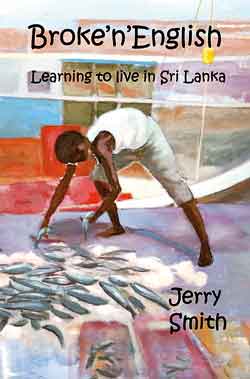A tale of wit and woe, some home truths and more
View(s): Another volume has recently been added to the expanding canon of books by foreigners about Sri Lanka. As a foreign resident here for nearly 40 years, I find such books fascinating for what they reveal about the personality of the author, rather than about Sri Lanka. Jerry Smith, from Britain, brings a different viewpoint about his involvement and investment in Sri Lanka because he married a woman who was herself born here, although of British parents.
Another volume has recently been added to the expanding canon of books by foreigners about Sri Lanka. As a foreign resident here for nearly 40 years, I find such books fascinating for what they reveal about the personality of the author, rather than about Sri Lanka. Jerry Smith, from Britain, brings a different viewpoint about his involvement and investment in Sri Lanka because he married a woman who was herself born here, although of British parents.
The story starts in June 1971 with a 13-year-old girl “standing with her parents at the end of the long pier stretching out an accusing finger from Talaimannar towards India.” Sally Martin (who became the author’s wife) was about to leave Ceylon with her parents, ending her family’s residency in the island, begun by her great grandfather, a British planter, after nearly 100 years. She was told she was going “home” but she was born in Colombo and soon realised that England, after a sunny and privileged life as the daughter of a tea plantation Visiting Agent, was definitely not her “home.”
The description of Sally’s childhood in a vivid and amusing way sets the tone of the book as well as serving as an introduction to the couple’s later adventures. It was 28 years before she was to return, when Jerry Smith surprised her with a holiday trip to Sri Lanka, where she was to discover that the Colombo mansion that was her childhood home had become an ice cream parlour.
In his account of his own life in England, Jerry drops hints about his character and life in Yorkshire as a civil servant, but one who in his spare time played in a band at folk festivals. Sally was his neighbour and the details of how he and she became a couple are revealed with self-effacing intimacy. Their life together and fun-filled pagan wedding in 1995 (after the official ceremony) foretells the folksy lifestyle they would eventually enjoy in Sri Lanka.
The chapter about his first visit in 1998 with Sally conveys all the astonishment of a first-timer who finds everyday life here either odd or out-dated. He hated the experience of staying in Hatton, enabling him to slip in a pun: “You can keep your Hatton.” The text is full of humorous asides like that, which we should expect given the magnificent pun of the title.There is suspense, too, as he recounts the hunt for gems deposited by Sally’s mother in a bank nearly 30 years before.
Accounts of his subsequent visits on holiday contain pithy observations such as this reference to Sigiriya, “The entrance charges for foreigners are as steep as the rock face.” Their search for a property to buy for their retirement is recounted in detail, including the warning they are given by a Sri Lankan that “white people pay skin tax.”
So it transpired, and the account of the ensuing mishaps in their determination to do what they had set out to do, should be read by any foreigner contemplating settling here. There are several home truths in this book, such as “Sri Lankans don’t do planning. They prefer to wait until something collapses – be it a roof, a car tyre or the economy – and then fix it.”
Yet the author and his wife survived every obstacle that came their way and this is not just a tale of wit and woe but also a candid description of their experiences in Sri Lanka. Sally, perhaps because of her roots here, sounds a very determined and practical woman not perturbed by hardships. The couple travel as Sri Lankans do, sometimes accompanied by their children and grandchildren, often to places that Sri Lankans rarely visit, unless they live in the area.
The author confesses to being an optimist and he proves it by his reaction to all the problems he encounters. After many years, their house – called Jungle Tide, near Kandy — is completed and Jerry and Sally quit England to settle there, becoming hosts for the many guests and volunteers from around the world who descend on them. They soon realise that their home “is not everyone’s cup of green tea.” The author comments that some guests simply don’t understand in advance where and what they are coming to. One Russian family complained on TripAdvisor “the pool has a shallow end and a deep end. This is dangerous for my grandmother.”
The book is self-published with the help of amazon.co.uk and, while it is written in a forthright style, I cannot help thinking that the author could have benefitted from an independent editor advising discretion on some of his riffs.
| Book facts | |
| Broke’n’English. Learning to live in Sri Lanka by Jerry Smith. Reviewed by Royston Ellis.Available through amazon.co.uk at £7.95 or from Barefoot at Rs. 2,000 |


